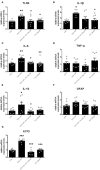Prokineticin Receptor Inhibition With PC1 Protects Mouse Primary Sensory Neurons From Neurotoxic Effects of Chemotherapeutic Drugs in vitro
- PMID: 33072073
- PMCID: PMC7541916
- DOI: 10.3389/fimmu.2020.02119
Prokineticin Receptor Inhibition With PC1 Protects Mouse Primary Sensory Neurons From Neurotoxic Effects of Chemotherapeutic Drugs in vitro
Abstract
Neurotoxicity is a common side effect of chemotherapeutics that often leads to the development of chemotherapy-induced peripheral neuropathy (CIPN). The peptide Prokineticin 2 (PK2) has a key role in experimental models of CIPN and can be considered an insult-inducible endangering mediator. Since primary afferent sensory neurons are highly sensitive to anticancer drugs, giving rise to dysesthesias, the aim of our study was to evaluate the alterations induced by vincristine (VCR) and bortezomib (BTZ) exposure in sensory neuron cultures and the possible preventive effect of blocking PK2 signaling. Both VCR and BTZ induced a concentration-dependent reduction of total neurite length that was prevented by the PK receptor antagonist PC1. Antagonizing the PK system also reduced the upregulation of PK2, PK-R1, TLR4, IL-6, and IL-10 expression induced by chemotherapeutic drugs. In conclusion, inhibition of PK signaling with PC1 prevented the neurotoxic effects of chemotherapeutics, suggesting a promising strategy for neuroprotective therapies against the sensory neuron damage induced by exposure to these drugs.
Keywords: DRG; chemotherapy; neurons; neurotoxicity; prokineticins.
Copyright © 2020 Moschetti, Kalpachidou, Amodeo, Lattanzi, Sacerdote, Kress and Franchi.
Figures







Similar articles
-
Interplay between Prokineticins and Histone Demethylase KDM6A in a Murine Model of Bortezomib-Induced Neuropathy.Int J Mol Sci. 2021 Nov 3;22(21):11913. doi: 10.3390/ijms222111913. Int J Mol Sci. 2021. PMID: 34769347 Free PMC article.
-
Targeting prokineticin system counteracts hypersensitivity, neuroinflammation, and tissue damage in a mouse model of bortezomib-induced peripheral neuropathy.J Neuroinflammation. 2019 Apr 17;16(1):89. doi: 10.1186/s12974-019-1461-0. J Neuroinflammation. 2019. PMID: 30995914 Free PMC article.
-
Prokineticin 2 promotes and sustains neuroinflammation in vincristine treated mice: Focus on pain and emotional like behavior.Brain Behav Immun. 2019 Nov;82:422-431. doi: 10.1016/j.bbi.2019.09.012. Epub 2019 Sep 13. Brain Behav Immun. 2019. PMID: 31525509
-
Chemotherapy-induced neurotoxicity: the value of neuroprotective strategies.Neth J Med. 2012 Jan;70(1):18-25. Neth J Med. 2012. PMID: 22271810 Review.
-
Vincristine-Induced Peripheral Neuropathy (VIPN) in Pediatric Tumors: Mechanisms, Risk Factors, Strategies of Prevention and Treatment.Int J Mol Sci. 2021 Apr 16;22(8):4112. doi: 10.3390/ijms22084112. Int J Mol Sci. 2021. PMID: 33923421 Free PMC article. Review.
Cited by
-
Therapeutic Potential of Targeting Prokineticin Receptors in Diseases.Pharmacol Rev. 2023 Nov;75(6):1167-1199. doi: 10.1124/pharmrev.122.000801. Epub 2023 Sep 8. Pharmacol Rev. 2023. PMID: 37684054 Free PMC article. Review.
-
Versatile Role of Prokineticins and Prokineticin Receptors in Neuroinflammation.Biomedicines. 2021 Nov 9;9(11):1648. doi: 10.3390/biomedicines9111648. Biomedicines. 2021. PMID: 34829877 Free PMC article. Review.
-
The Prokineticin System in Inflammatory Bowel Diseases: A Clinical and Preclinical Overview.Biomedicines. 2023 Nov 6;11(11):2985. doi: 10.3390/biomedicines11112985. Biomedicines. 2023. PMID: 38001985 Free PMC article. Review.
-
Interplay between Prokineticins and Histone Demethylase KDM6A in a Murine Model of Bortezomib-Induced Neuropathy.Int J Mol Sci. 2021 Nov 3;22(21):11913. doi: 10.3390/ijms222111913. Int J Mol Sci. 2021. PMID: 34769347 Free PMC article.
-
Evidence-Based View of Safety and Effectiveness of Prokineticin Receptors Antagonists during Pregnancy.Biomedicines. 2021 Mar 17;9(3):309. doi: 10.3390/biomedicines9030309. Biomedicines. 2021. PMID: 33802771 Free PMC article.
References
Publication types
MeSH terms
Substances
LinkOut - more resources
Full Text Sources
Research Materials
Miscellaneous

